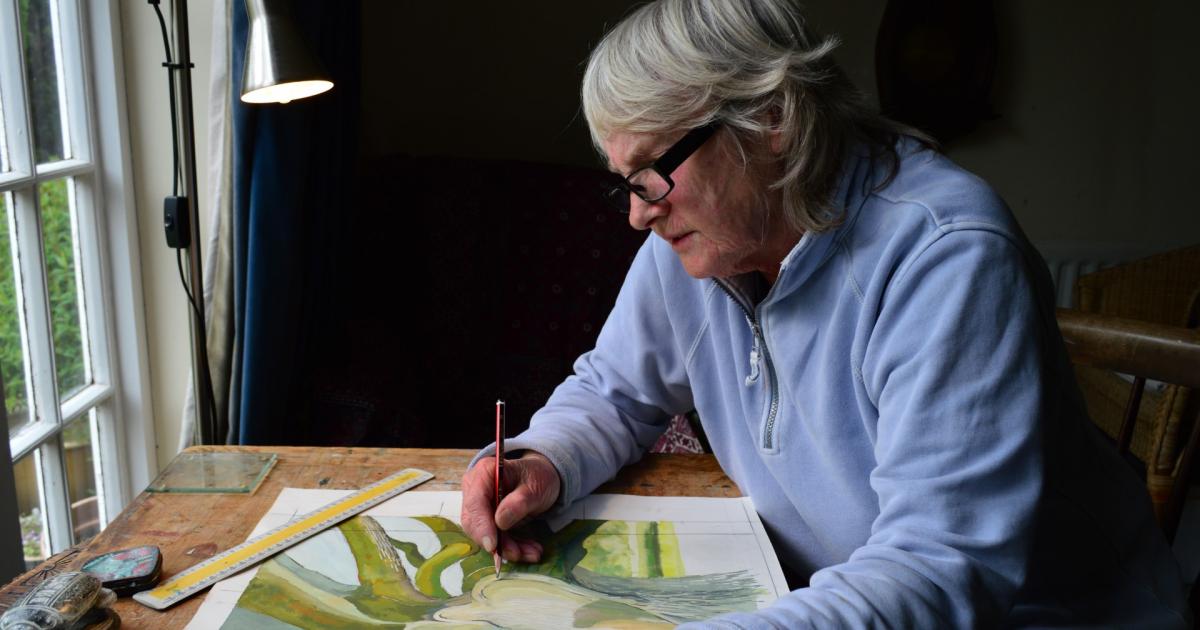Rachel Fenner, who lived near Winchester, was an environmental artist and sculptor known for her public artworks, including the Hampshire Jubilee Sculpture outside Winchester Crown Court.
She died on Saturday, July 12, and leaves behind two sons, Bevis and Nick.
Her career spanned more than five decades and included sculpture, painting, and large-scale public commissions.
Rachel trained in both sculpture and painting at Wimbledon School of Art, before completing four years of postgraduate study at the Royal College of Art’s Sculpture School.
Rachel Fenner with Her Majesty The Queen (Image: STUART MARTIN)
She went on to teach at Wimbledon, West Surrey College of Art in Farnham, and Winchester School of Art.
Her early career focused on studio and gallery work, exhibiting widely across London and the South until 1978.
In 1979, she was awarded an Arts Council fellowship to work with Portsmouth City Council, where she developed a pilot scheme exploring the concept of ‘Art as Environment’.
This led to a series of public art projects that integrated art directly into the fabric of public spaces.
Her works included earthworks, bronze casts, mosaics, brickwork, gates, seating, and trellises.
Many of these pieces served as markers for archaeological sites within urban environments.
Rachel Fenner (Image: Bevis Fenner) One of her most recognisable works is the Hampshire Jubilee Sculpture, completed in November 2003 and installed on the Law Courts Terrace in Winchester.
Commissioned by Hampshire County Council, the sculpture commemorates the coronation of Queen Elizabeth II.
Other notable projects include the Link Stone Fountain in Malvern and the Siloh Square scheme in Ystrad Mynach, South Wales.
Beyond public art, Rachel also produced domestic-scale sculptures in wood, stone, and bronze.
The unveiling of the sculpture (Image: STUART MARTIN) Her smaller works were highly abstracted but often inspired by nature, water, and ancient British sites.
She was also a respected painter, with works following the British tradition of romantic abstract landscapes.
Her paintings drew heavily on the coastal scenery of Pembrokeshire and Dorset, as well as the history of ancient Britain.
Critic John Russell Taylor of The Times wrote: “Rachel Fenner makes paintings which make one wonder if she has just this instant invented abstraction, all by herself.
“Like much English abstraction, hers seems to be landscape-based.
“That is to say, one can suspect that one is seeing a transmogrified cornfield, branches against the moon, cracks in the ice and such, without ever being able to pin down these associations unequivocally.
“But what is important is that they exist, and give Fenner’s gouaches a grandly romantic, faintly melancholy quality somewhere in the same emotional area as late Paul Nash.”
(Image: Newsquest) Born in Scarborough, Yorkshire, Rachel received a Sainsbury Award Grant in 1966.
She taught at several colleges, including Winchester School of Art, and was a visiting lecturer at the Royal Academy Schools from 1974 to 1976.
She received an Arts Council Major Award in 1976, among other honours.
Her solo exhibitions included shows at House (1976), Taranman and the DLI Museum and Arts Centre in Durham (both 1978), Aspex Gallery in Portsmouth (1981), Abbot Hall Art Gallery in Kendal (1981), and Duncan Campbell Contemporary Art (from 1993).
Among her many public commissions were the Saxon Column for Hamwick in Southampton (1989–90) and Earthworks for Castle Park in Bristol (1991).
A small private funeral for close friends and family will be held soon.

